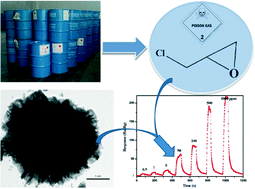Epichrorohydrin (ECH) is an important reagent in the industrial production of glycerol, epoxy resins and polymers used in the paper and food industries. However, it is toxic to humans by inhalation, by absorption through the skin and by ingestion – and it is a cancer suspect agent. Accurate and reliable detection of ECH gas is therefore required so that risks can be monitored and minimised. Semiconductor materials like tin dioxide (SnO2) are one possibility – they are highly sensitive to gas absorption but their lack of sensitivity to individual gases is problematic. One method of improving sensitivity is to dope the material with noble metals.
A new paper describes the preparation of porous SnO2 materials decorated with 5-15% Ag. These have a diameter of 4-5 μm and consist of nanosheets. The ECH sensing properties of the new materials were studied and the 10% doped sample was found to give the best performance. It showed a fast response and recovery time, high response, good selectivity and a detection limit of 0.5 ppm, rendering it a promising material for use in ECH detection.
For more information see the paper:
Selective epichlorohydrin-sensing performance of Ag nanoparticles decorated porous SnO2 architectures
Zhenglin Zhang, Haiyan Song, Shishu Zhang, Junyan Zhang, Wenya Bao, Quanqin Zhao and Xiang Wu
CrystEngComm, 2014, Advance Article
DOI: 10.1039/C3CE41478G, Paper
 Gwenda Kyd has a PhD in metallocarborane chemistry from the University of Edinburgh. Other research work includes the spectroscopic study of the structure of glasses and organometallic electron-transfer reactions and the preparation of new inorganic phosphors. Currently she is writing a book on chemicals from plants.
Gwenda Kyd has a PhD in metallocarborane chemistry from the University of Edinburgh. Other research work includes the spectroscopic study of the structure of glasses and organometallic electron-transfer reactions and the preparation of new inorganic phosphors. Currently she is writing a book on chemicals from plants.










